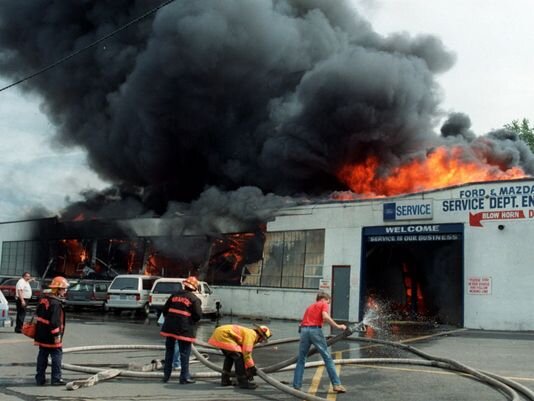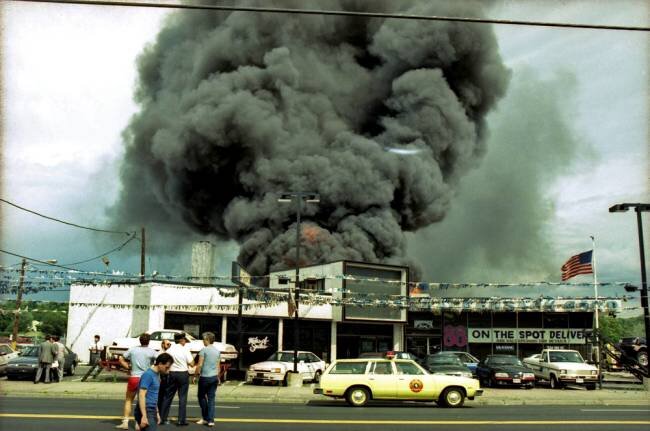Learn From History: The Hackensack Ford Fire
Sometimes, as time moves Friday July 1, 1988 was an unusually on, stories need to be retold, to preserve the “lessons learned” for new generations. This year, 2018, marks the 30 year anniversary of the fire at the Hackensack NJ Ford dealership at which 5 firefighters were killed when the bowstring truss roof collapsed during fire operations. Below is the retold story.
The City of Hackensack is located in northern NJ, about 5 miles west
of New York City at the George Washington Bridge. The city encompasses about 46,000 residents in a 4.5 square mile area. The FD, fully paid since 1914, has maintained a strength of about 100 members for the last 35 years, although during the mid 1970’s had a high total of 117 members. 4 Engine companies, 1 ladder Co., a Rescue Co. (Rescue only as staffing permitted before 1998) and a tour commander are staffed, and the Dept. maintains several reserve & spare apparatus.
Friday July 1, 1988 was an unusually cool, cloudy summer day. People were readying themselves for a long holiday weekend, when at 301pm, a call was received at Fire Headquarters, reporting a fire at the Ford dealership located at 332 River St. 2 engines, a ladder co. and a Battalion chief responded.
On arrival units found light to moderate smoke showing from the roof area over the service bays of a 225’x80’ 1-2 story auto dealership.
the building was constructed in about 1940, was of ordinary, type 3 construction, and had a concealed, heavy timber bowstring truss roof over the service area. The building did not contain sprinklers or an automatic fire detection system. There were no other exposures endangered.
Engine 4, the first due-engine, dropped a 3”feeder line from a hydrant, then stretched a 1-1/2” line up a stairway on the west side of the service leading to the truss/loft area. (common use of hose line sizes at the time). There was excessive storage in the center of the truss area, and heavy smoke/heat. This avenue of attack was not continued for unknown reasons.
An additional engine was requested, and a recall of off duty members was initiated. The ladder co., using a spare 100’ American LaFrance truck, laddered the roof and began ventilation. There was heavy smoke emitting from a ventilation-fan opening. They then proceeded to open the roof.
The second-due and third engines worked together to operate another 1-1/2” into a hatchway in the ceiling of the shop area, underneath the bowstring truss roof, via a portable (FD) ladder. All employees were accounted for, and were attempting to remove parked vehicles around the building. The attack continued, along with the roof ventilation. There were 14 members operating on scene at this time. About 25 minutes into the job, conditions started to deteriorate rapidly. the 4th due engine was requested to the scene, with orders to prepare to supply the ladder pipe of the ladder co.
and the B/C ordered “all units to back out of the building and off the roof.” The Chief of Dept. was arriving on scene at this time. There were no acknowledgements of this order and units were slow to retreat. It is to be noted at the time of the fire, only officers had portable radios which operated only on the main dispatch channel. The main shop area remained virtually smoke-free, as heavy fire now vented from a portion of the roof. 35 minutes into the incident one heavy truss violently collapsed with a thunderous roar. 3 members were crushed and believed to be killed instantly. One member was able to escape the collapse, and 2 members retreated to a dead-end tool room with no windows on the east end of the building.
An additional alarm was sounded, bringing reserve apparatus, off duty members and subsequently mutual aid co’s to the scene. The Department’s Mack Tower Ladder, at the city garage for repair work, was returned to service and brought to the scene and put into operation.
The two members became trapped in the tool room. One being a Lt., called for help numerous times over his portable radio numerous times. He was not acknowledged on every plea for help: “we’re running out of air.” Some transmissions were stepped on by Headquarters transmitting over the lone radio frequency. Additional trusses began collapsing, and members on-scene attempted to advance/direct hose lines into that area.
There were no such thing as a FAST or RIT or 2 in/2 out in the fire service in 1988. There was no formal rescue attempt made, although informal rescue attempts were made by several members on scene. Control of the incident was lost by the chief officers on scene. Arriving recall members were not aware that members were trapped or unaccounted for. Communication was lacking. Several members, including an off duty FDNY firefighter, breached a wall on the east side of the building into the tool room, but it was too late.
Eventually, more mutual aid companies arrived on scene and brought the fire under control. The fire destroyed the service area and spread into the office/showroom area of the building. When conditions permitted, Hackensack members went in to search for and recover the bodies. After the removal of the bodies, all Hackensack members were relieved from the scene and mutual aid companies finished overhauling and extinguishing hot spots and picked up all hose and equipment. Eerily, a giant rainbow appeared in the sky to the east after brief rain shower.
The fire claimed the lives of:
- Capt. Richard Williams, a 24 year member
- Lt. Richard Reinhagen a 23 year member
- Firefighter William Krejsa a 24 year member
- Firefighter Leonard Radumski a 14 year member
- Firefighter Steve Ennis a 5 year member
There were numerous working fires in the city over the summer and during the remainder of the year, including a fire in a vacant house on July 2nd, a general alarm fire in an electrical supply warehouse in August, a serious high rise fire in December and a daytime house fire a few days later in which several children were killed. 6 new firefighters were hired at the beginning of August.
Four investigations were conducted into the cause origin, tactics and inspection practices at the fire. These were conducted by the Bergen County Prosecutors office (cause and origin: believed to have started in the area of the large attic fan, but listed as undetermined), NFPA, NJ Division of Fire Safety and an independent consultant hired by the IAFF local 2081 Hackensack Firefighters association.
The factors contributing to the deaths of the five members were as follows:
-Heavy timber bowstring truss roof
-Failure to recognize the truss roof and collapse hazards of truss roofs
-Substantial amount of combustible storage in truss space, adding to fire load and load on trusses and lack of building inspections.
-Lack of fire detection in truss/attic space and a delayed alarm
-Lack of available staffing to mount an effective rescue effort after collapse
-No effective command structure before and after the collapse
-Only one available radio frequency for fire and dispatch operations
-PASS alarms were not issued
Weeks after the fire the firefighters union asked the city to increase the minimum staffing on each company from 3 to 4. (This was never implemented to this day; however, companies are staffed with 4 members when manpower permits.)
The most immediate improvements were the issuing of more portable radios for members on duty concurring with the implementation of a fire ground channel in the fall of 1988. Eventually in the early 90’s all on duty members were issued portable radios. The other improvement was the issuance of PASS alarms to all department members. These were donated by a local businessman. In the fall of 1988, all members received formal training in building construction.
Also in the fall of ’88, all companies surveyed every commercial building in the city to identify if the building had a truss roof of any type. This information was entered into an early generation computer data system available to dispatchers who could relay the information to the tour commanders. The city then passed an ordinance requiring a truss placard/emblem on any building with a truss roof other than a private dwelling. (This was later adopted by the state of NJ)
Other changes took place over the next several years albeit slowly at times.
SOP’s for all types of fires and responses were developed. The Dept. was one of the first in the state to receive training in and implement the Incident Command system. ( ICS Eventually became mandatory in NJ to be implemented at all fires.)
A Safety committee was formed and several members attended the NFA and received certification as safety officers. The city established on operations chief position in the Dept. to oversee day to day operations and assist at fire scenes. A formal accountability system was developed and implemented. An officer was assigned to the Rescue co., which at the time of the fire was only staffed when manpower was available and operated as second section of the Ladder Co.
In 2013 the Hackensack Fire Department received an ISO class 1 rating, one of only 3 Departments in NJ at the time of this writing.
In 1988 the fire service seemed to be changing. Networking was becoming more common, through books, magazines and training seminars. The job seemed to be changing from experience based to training based. Similar tragedies occurred in 1967 in nearby Cliffside Park NJ where 5 firemen were killed when a bowstring truss roof collapsed at a bowling alley fire pushing out a bearing wall, and the Waldbaums supermarket fire in Brooklyn in August 1978 where 6 FDNY firefighter were killed when the truss roof collapsed. These tragedies did not receive the national attention that Hackensack did. It has been cited as one of the top 25 influential fires in American history. The video from the fire, available on Youtube, is still used to train firefighters about what can happen at a fire in a building with a truss roof.
Hopefully, the lessons learned from this fire prevented other firefighters from being killed or injured and will continue to carry on into the future.
HACKENSACK LODD
Friday July 1, 1988 Hackensack Ford
NEVER FORGET
Captain Richard Williams
Lieutenant Richard Reinhauen
Firefighter Leonard Radumski
Firefighter William Krejsa
Firefighter Steve Ennis
















